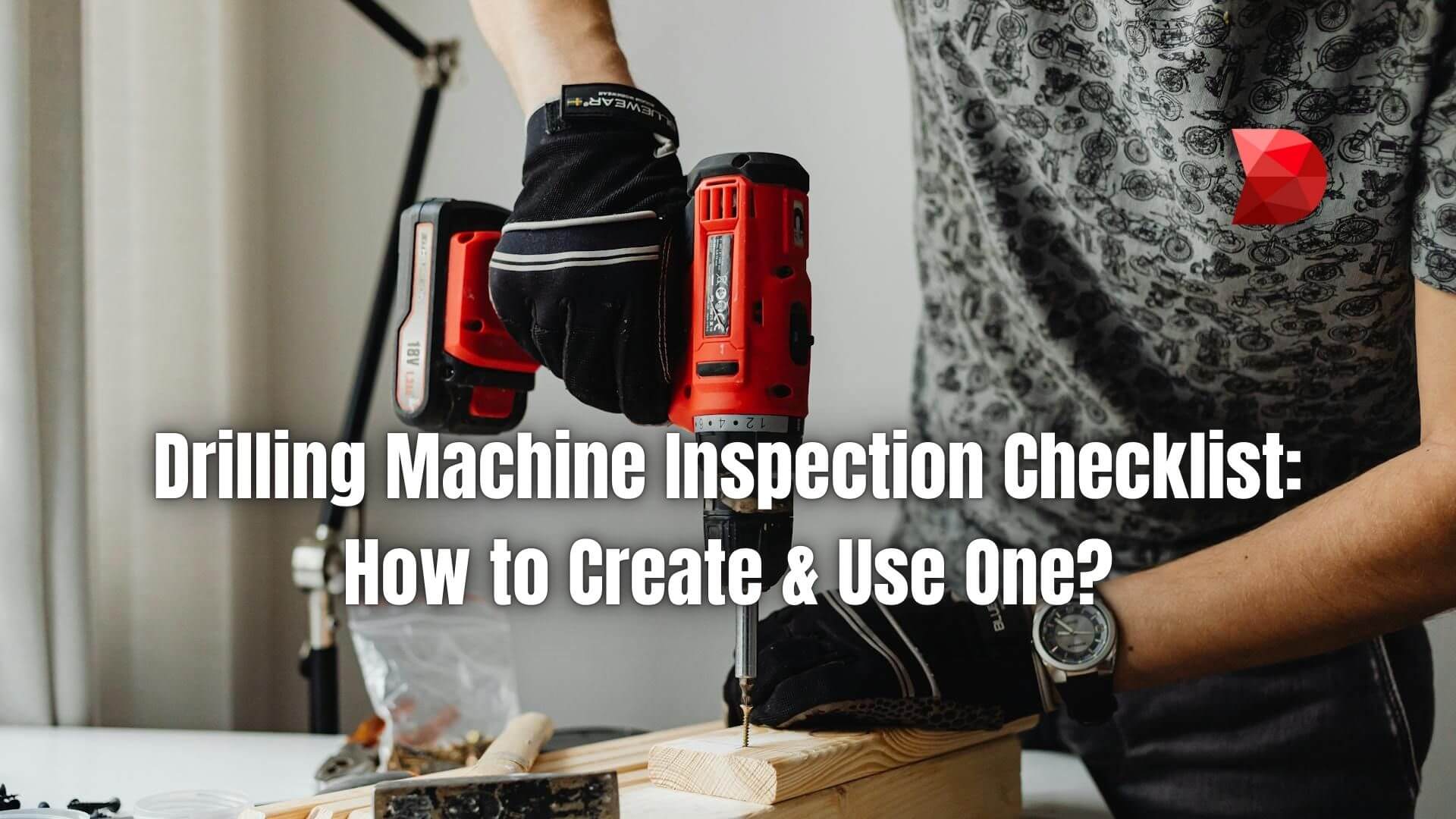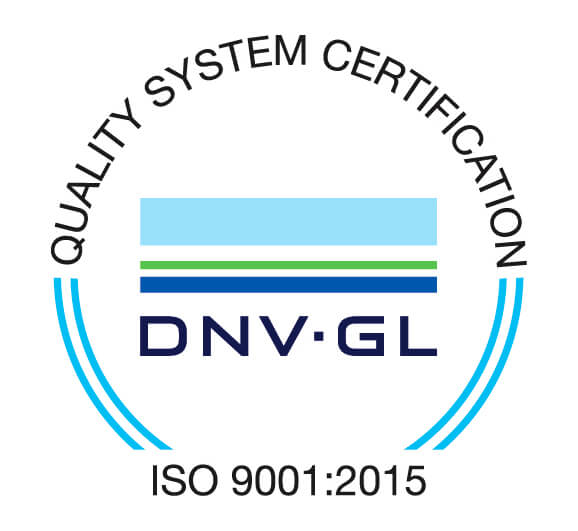A drilling machine is essential equipment used in many industries. Like any other piece of machinery, it requires regular inspection and maintenance to ensure safety and efficiency during operations.
A drilling machine inspection checklist can help keep your drilling machine in top condition by providing a roadmap on what needs to be inspected and maintained regularly. This article will explain a drilling machine inspection checklist, how to make one, and why it’s essential for keeping drilling machines running at optimum capacity.
Table of Contents
ToggleWhat is a Drilling Machine Inspection?
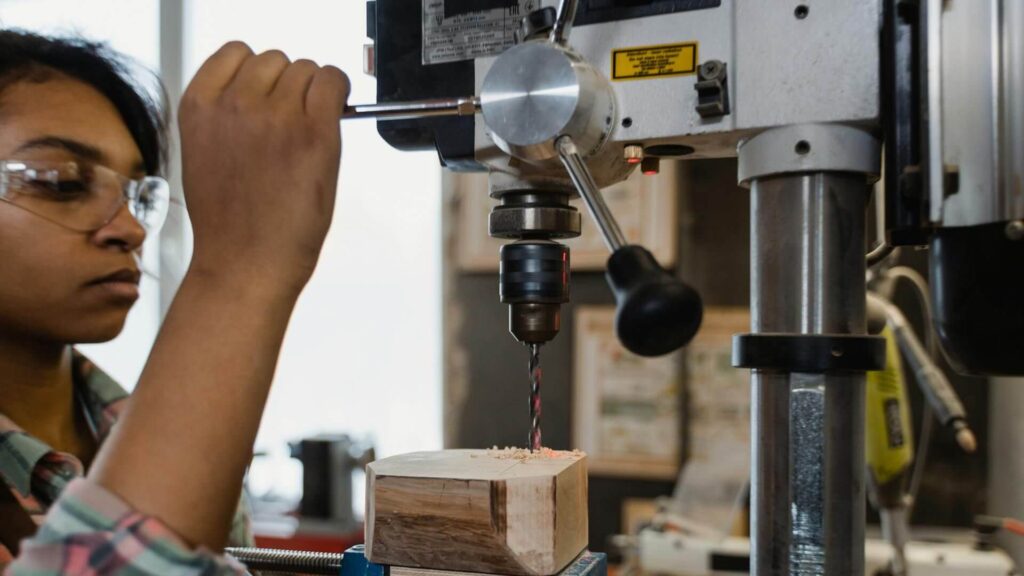
As an integral tool for drilling projects and operations, drilling machines require regular inspections to ensure they work in optimal condition. This includes checking for damages, wear, and tear and assessing the machine’s performance.
An extensive guide to what to look for during an inspection, a drilling machine inspection checklist lists the important parts of the machine that need to be examined and what to do if anything is discovered.
The Critical Role of Drilling Machine Inspection
A drilling machine is a fundamental tool in many industries, and its proper functioning is essential for ensuring efficient operations and safety. Regular inspections are not merely a formality but a crucial aspect of maintaining the machine’s reliability and preventing costly downtime. The following are some notable reasons why drilling machine inspection is essential:
- Safety: A faulty drilling machine can pose significant safety risks to operators and surrounding personnel. Regular inspections help identify potential hazards, such as loose parts, faulty wiring, or worn components, and prevent accidents.
- Efficiency: A well-maintained drilling machine operates more efficiently, leading to increased productivity and reduced production time. Regular inspections can help identify and address issues that may hinder the machine’s performance.
- Cost-Effectiveness: Preventive maintenance through regular inspections can save money in the long run. By identifying and addressing minor problems early on, you can avoid costly repairs or replacements and minimize downtime due to machine failure.
- Compliance: Many industries have safety regulations and standards that require regular inspections of equipment, including drilling machines. Adhering to these regulations is essential for avoiding legal and financial penalties.
By prioritizing drilling machine inspections, you can ensure the safety, efficiency, and cost-effectiveness of your operations.
Versatile Drilling Machines: A Wide Range of Applications
Drilling machines are indispensable tools in various applications. Their versatility allows them to perform a multitude of tasks, from precise hole-making to heavy-duty drilling operations. Here are six notable applications of drilling machines:
- Manufacturing: Drilling machines are extensively used in manufacturing processes to create precise holes in a variety of materials, including metals, plastics, and wood. They are essential for producing components for machinery, automotive parts, and other products.
- Construction: In the construction industry, drilling machines are used for a wide range of tasks, such as drilling holes for anchors, creating openings for plumbing and electrical installations, and preparing surfaces for fastening.
- Metalworking: Metalworking shops rely on drilling machines to create holes in metal components for various purposes, including machining, assembly, and fabrication.
- Woodworking: In woodworking shops and furniture manufacturing, drilling machines are used to create holes for joints, dowels, and other components. They are also used for drilling pilot holes for screws and nails.
- Repair and Maintenance: Drilling machines are essential tools for repair and maintenance work. They allow for the removal of damaged or worn parts and the installation of replacements.
- Hobby and DIY: Drilling machines are popular tools for hobbyists and DIY enthusiasts, enabling them to create projects such as woodworking, metalworking, and home improvement.
What is a Drilling Machine Inspection Checklist?
A drilling machine inspection checklist lists guidelines and points to inspect during a drilling machine inspection. It covers all aspects of the drilling machine that need to be monitored, such as drilling machine components, drilling tools, drilling fluid, and the drilling environment.
The checklist will also provide an action plan if anything is wrong or malfunctioning. This includes what needs to be done immediately and any follow-up inspections that may be necessary to ensure drilling machine safety.
Essential Components of a Drilling Machine Inspection Checklist
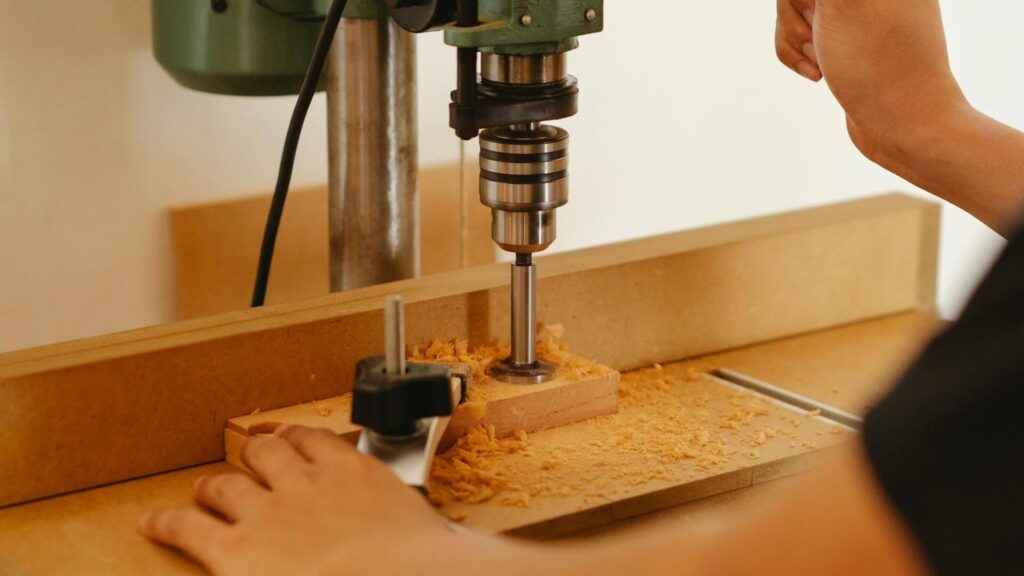
A comprehensive drilling machine inspection checklist should include a variety of items to ensure the machine’s safety and functionality. Here are some key elements to consider:
Basic Information
- Company Name: The name of the company or organization that owns or uses the drilling machine.
- Date of Inspection: The specific date when the inspection is conducted.
- Make: The manufacturer of the drilling machine.
- Model: The specific model or type of drilling machine.
- Number: A unique identification number for the machine.
- Owned/Hired/Contractor: Indicate whether the machine is owned by the company, hired, or contracted.
Machine Condition
- Physical Soundness: Verify that the machine is structurally sound and free from any obvious defects or damage.
- Working Condition: Ensure that all components of the machine are functioning as intended.
Electrical Safety
- Power Cable: Inspect the power cable for signs of damage, such as cuts, fraying, or exposed wires.
- Flexible Cable: If applicable, verify that a flexible cable is provided to prevent damage to the main power cable.
- Dead Man Switch: Check the dead man switch for proper operation and ensure it is not damaged.
Operator Safety
- Handle: Confirm the presence of a handle for a secure grip and better control.
- Drill Bit: Inspect the drill bit for damage, such as cracks or chips.
- Drill Bit Removal: Ensure that a designated key is used to remove and change drill bits, preventing accidental injuries.
Machine Safety
- Insulation: Verify that the drilling machine has double insulation or grounding to protect the operator from electrical hazards.
- Drill Stop: Check if an adjustable drill stop is available and used when necessary.
Operator Qualification
- Competence: Ensure that the machine is operated by a person who is experienced and competent in its use.
Inspection Documentation
- Fit for Use: Indicate whether the drilling machine is deemed fit for use based on the inspection results.
- Inspector Information: Include the name, department, designation, and signature of the person conducting the inspection.
- Review: Provide space for a supervisor or manager to review the inspection results, including their name, department, designation, and signature.
Developing a Comprehensive Drilling Machine Inspection Checklist
Creating a well-structured drilling machine inspection checklist is essential for ensuring the safety and efficiency of your operations. Follow these steps to develop a checklist that meets your specific needs:
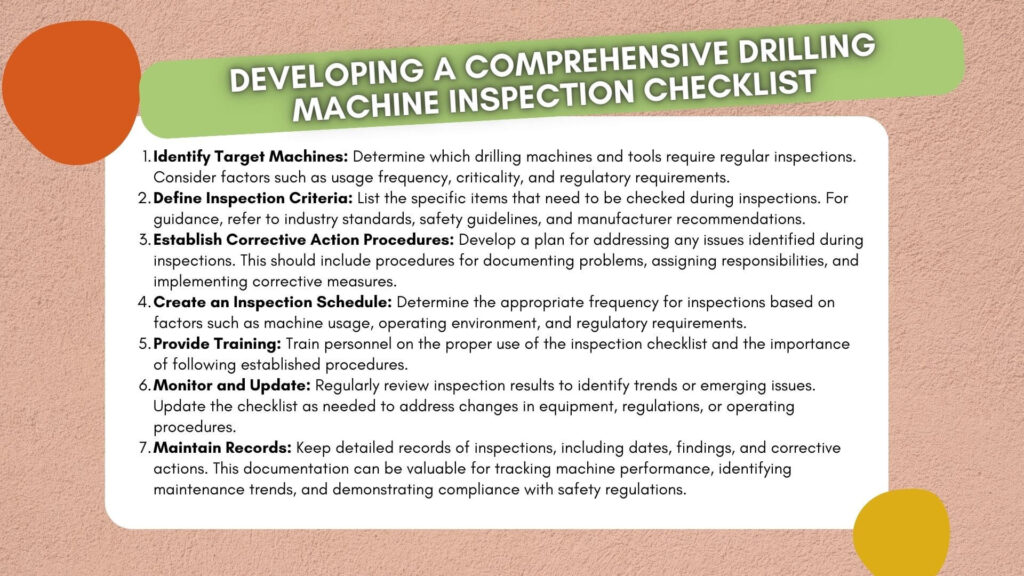
-
- Identify Target Machines: Determine which drilling machines and tools require regular inspections. Consider factors such as usage frequency, criticality, and regulatory requirements.
- Define Inspection Criteria: List the specific items that need to be checked during inspections. For guidance, refer to industry standards, safety guidelines, and manufacturer recommendations.
- Establish Corrective Action Procedures: Develop a plan for addressing any issues identified during inspections. This should include procedures for documenting problems, assigning responsibilities, and implementing corrective measures.
- Create an Inspection Schedule: Determine the appropriate frequency for inspections based on factors such as machine usage, operating environment, and regulatory requirements.
- Provide Training: Train personnel on the proper use of the inspection checklist and the importance of following established procedures.
- Monitor and Update: Regularly review inspection results to identify trends or emerging issues. Update the checklist as needed to address changes in equipment, regulations, or operating procedures.
- Maintain Records: Keep detailed records of inspections, including dates, findings, and corrective actions. This documentation can be valuable for tracking machine performance, identifying maintenance trends, and demonstrating compliance with safety regulations.
Sample Drilling Machine Inspection Checklist Template
A well-structured inspection checklist is essential for ensuring the safety and reliability of your drilling machines. The following sample checklist provides a comprehensive framework that can be adapted to your specific needs.
General Information
- Company Name: [Insert Company Name]
- Date of Inspection: [Insert Date]
- Machine Identification:
- Make: [Insert Make]
- Model: [Insert Model]
- Serial Number: [Insert Serial Number]
- Location: [Insert Location]
Machine Condition
- Physical Appearance:
- Free from visible damage (cracks, dents, etc.)
- Clean and free of debris
- Functional Testing:
- Spindle rotation: Smooth and without excessive noise or vibration
- Feed mechanism: Operates smoothly and accurately
- Chuck: Clamps securely and releases easily
- Safety Features:
- Emergency stop button: Functions properly
- Guards: In place and secure
- Coolant system: No leaks or blockages
Electrical Components
- Power Supply:
- Correct voltage and amperage
- Wiring: Secure and undamaged
- Grounding: Proper grounding connection
- Motor:
- Operates smoothly without excessive noise or vibration
- No overheating or unusual smells
Operator Safety
- Handle: Secure and comfortable grip
- Controls: Clearly labeled and easy to use
- Noise Levels: Within acceptable limits
- Vibration Levels: Within acceptable limits
Maintenance Records
- Previous Inspections: Date, findings, and corrective actions
- Maintenance History: Dates, type of maintenance, and performed by whom
Inspection Results
- Overall Condition: Satisfactory / Unsatisfactory
- Issues Identified: [List any issues found]
- Corrective Actions: [Describe necessary repairs or adjustments]
Inspector Information
- Name: [Insert Name]
- Department: [Insert Department]
- Signature: [Insert Signature]
- Date: [Insert Date]
Reviewer Information
- Name: [Insert Name]
- Department: [Insert Department]
- Signature: [Insert Signature]
- Date: [Insert Date]
Frequently Asked Questions (FAQs)
Q1: What is the ideal frequency for drilling machine inspections?
The ideal inspection frequency depends on factors such as machine usage, operating environment, and regulatory requirements. However, a general guideline is to conduct regular inspections, such as daily, weekly, or monthly, based on the machine’s criticality and the potential consequences of failure.
Q2: Can I perform drilling machine inspections myself, or do I need specialized training?
While operators with proper training can perform basic inspections, more complex or specialized inspections may require the expertise of trained technicians or engineers. Assessing the complexity of your drilling machines and the potential risks involved is essential to determining the appropriate level of expertise required.
Q3: How can I ensure that my drilling machine inspection checklist is comprehensive and effective?
To create a comprehensive checklist:
- Refer to industry standards, safety guidelines, and manufacturer recommendations.
- Consider factors such as the machine’s specific components, operating conditions, and potential hazards.
- Regularly review and update your checklist to address changes in equipment, regulations, or operating procedures.
Q4: What should I do if I identify a problem during a drilling machine inspection?
If you identify a problem, immediately take steps to address it to prevent further damage or safety hazards. Document the issue, assign responsibilities for corrective action, and implement necessary repairs or adjustments.
Q5: How can I improve the efficiency of my drilling machine inspection process?
To improve efficiency, consider using digital tools or software to streamline the inspection process and record findings. Train personnel on the proper use of the inspection checklist and provide clear guidelines for reporting and addressing issues.
Q6: Are there any specific regulations or standards that I need to follow for drilling machine inspections?
Depending on your industry and location, there may be specific regulations or standards that govern drilling machine inspections. Research and comply with applicable regulations to ensure safety and legal compliance.
Conclusion
A well-maintained drilling machine is essential for ensuring safety, efficiency, and productivity in various industries. Regular inspections play a critical role in identifying potential problems and preventing costly downtime.
By following the guidelines outlined in this article, you can create a comprehensive drilling machine inspection checklist that addresses the specific needs of your operations. Remember to:
- Identify target machines: Determine which drilling machines require regular inspections.
- Define inspection criteria: List the items that need to be checked.
- Establish corrective action procedures: Develop a plan for addressing identified issues.
- Create an inspection schedule: Determine the appropriate inspection frequency.
- Provide training: Train personnel on the proper use of the inspection checklist.
- Monitor and update: Regularly review inspection results and update the checklist as needed.
Implementing a robust inspection program can significantly improve the safety, reliability, and performance of your drilling machines.
Streamline Drilling Machine Inspections with DATAMYTE
DATAMYTE is a quality management platform with low-code capabilities. Our Digital Clipboard, in particular, is low-code workflow automation software that features a workflow, checklist, and smart form builder. This tool lets you streamline drilling machine inspections by creating and using a customized checklist that ensures thorough and consistent evaluations, reducing the risk of equipment failure and downtime.
DATAMYTE also lets you conduct layered process audits (LPA), a high-frequency evaluation of critical process steps, focusing on areas with the highest failure risk or non-compliance. Conducting LPA with DATAMYTE lets you effectively identify and correct potential defects before they become major quality issues.
With DATAMYTE, you have an all-in-one solution for efficiently managing and optimizing your drilling machine inspections. Book a demo now to learn more.

